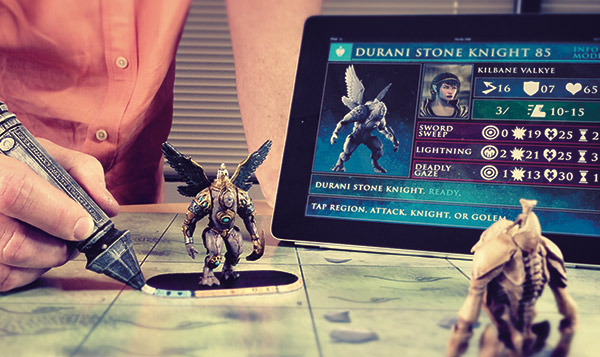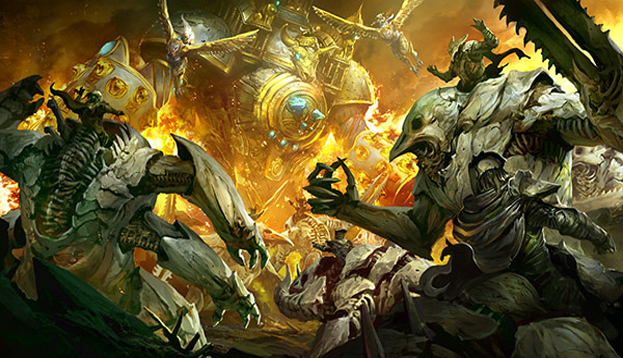Jordan Weisman should be looking at his next Kickstarter campaign with all the confidence of a competitive swimmer looking down a familiar pool. After all, he raised over four times what he asked for Shadowrun Returns, collecting about $1.8 from more than 36,000 backers. Talking to him last Friday on the eve of launch for his next one, Golem Arcana, at one point he sounded more like a kid staring down a murky pond on the first day of camp.
“I’m very scared but we’ll see. Anytime you’re trying a new property and a new dynamic, it’s always a little scary. If you’re not scared, then you didn’t push yourself enough,” he told me at the end of our interview, right before he went into final planning for the campaign.
It launched on Tuesday. Based on how it’s trending, things are going swimmingly. The campaign has already received pledges for more than a quarter of the $500,000 it’s trying to raise, and that’s with 32 days to go.
Golem Arcana is new on a couple of fronts. It’s a brand new IP for Weisman and his studio, Harebrained Schemes. That part of it is old hat for Weisman. He has a string of original properties to his name going back to Shadowrun and Battle Tech at his first studio, FASA. That has continued through his most recent ventures with WizKids, Smith and Tinker, and now Harebrained, which have all been pretty much focused on creating new IP. The part that’s probably scaring him the most is the new game play dynamic Golem Arcana is introducing, which Harebrained describes as a digitally enhanced miniatures game.
There’s seemingly no reason to be scared. It’s one of those concepts where you can’t imagine why no one thought of it before. Golem Arcana combines a miniatures table top game with a software app and a device where the two interact digitally. That concept of enhancing a board game with a digital component isn’t new. Golem Arcana is just doing it in such a polished, smartly organized way, and for one of the most complex kinds of physical games.
“I’ve always loved table top games,” said Weisman. “There’s just an energy in the theme, a visual dynamic, and a tactile dynamic. I’m always looking for ways to make table top games more accessible, and yet at the same time richer and deeper.”
The truth with table top games is that they do require work, which limits their appeal. That’s what Golem Arcana strips away. Forget record keeping, flipping through a rule book, tabulating results — it takes the pen and paper out of it. All of that is thanks to combining familiar technology, with a Bluetooth enabled digital stylus that interacts with a software app designed for tablets. The app is the game manager, the rule book and the referee. The stylus uses a built-in camera that reads microdots painted on the game map, on the figurines, and on the cards. Tapping with the stylus on aspects of the physical board game brings up those same elements on the tablet screen, be it a section of the map or the characters in play. Players can then interface with the tablet — using swipe, not stylus — to figure out the outcome of a move or rules and abilities related to what they want to do.
As Weisman put it, that crossing of table top meets video game opens the door for a lot of mechanics that gamers of all types have become accustomed to.
“What’s cool is that because it’s digitizing the game as you play it, there are all of these kinds of features that were only available to video games [that] are now available to table top games. Things like you have information flow for leaderboards seamlessly so you can do all sorts of fun tournament leagues or organized play.”
In the Kickstarter video, Weisman adds this compelling dynamic: “Or how about a board game with a save feature.”
The underlying story in Golem Arcana is that age-old battle between empire and insurgency. The game universe revolves around Golems, a kind of ancient battle mech, so it’s not too far out of the wheelhouse for what Weisman has worked on before. In fact for all of his successes in games, this project feels like the culmination of what he’s worked on over the past decade. I asked him whether his work at pre-Harebrained startups WizKids and Smith and Tinker led to this.
“WizKids was not technological but a game design and manufacturing approach, and a unique way to encapsulate all that data onto a physical figure itself. Smith and Tinker though, you’re right, was a technology play with its own hardware and about trying to find some of the dynamics of online games and bringing it to digital trading card types of games. You could look at both of those experiences as bringing us to Golem Arcana.”
The miniatures shown in Golem Arcana look like the stuff of Christmas mornings, which Weisman points out come already painted and ready to play. Each set of figures represents a faction in the game whose weapons, armor and Golems are crafted from a specific element of nature — plants, metals, soil and bone. That unique aspect of each figurine’s material base comes across in magnificently detailed character design. Glimpses of the app also showcase something that’s very polished, showing the characters and game map in 3D. Still, Weisman points out that everything shown in the Kickstarter, as polished as it seems, is only a prototype. Game design, stylus functionality, further app development, backend infrastructure for game data – all of that still needs to be fully developed, which the Kickstarter will hopefully fund.

It does seem as if Harebrained would have the resources to bring Golem Arcana to fruition on its own. The product also has such potential, and with a known team behind it, that it likely could have attracted investors even if Harebrained’s own coffers couldn’t support its development. Weisman sees benefits outside of just monetary backing by going the crowd funding route.
“I think the part and parcel of it is that it’s an effective way to talk to our audience and see if this is something they’re interested in. This is a brand new property, it’s a brand new way to play. From that perspective it’s certainly a higher risk in a sense.”
Weisman said he hopes their legacy on Kickstarter helps this campaign, but then added, “Frankly, if people don’t express a lot of interest in it, well then we’re glad we didn’t just spend a year in development.”
Harebrained’s Kickstarter hasn’t left a lot of room for ‘Good Samaritan’ donors on this one. To some extent, it really does feel like a pre-order campaign. Backing the project starts at a $10 tier, where people can choose items from the final game piece by piece for the money they invested. It then shoots up to a $55 tier where backers get the starter kit version of the game, valued at $75 if it ever retails. The ‘Daddy Warbucks’ tier doesn’t go as high as most Kickstarters either, topping at $2,000. The big prize there is getting your likeness and input for a major storyline-changing character, which Harebrained pitches as a chance to become “the Alexander Kerensky or Harlequin of this universe.” I had to look up the references to figure out their historical significance, and while it’s safe to assume they were stuck in there for comic relief, there’s some truth to pinning world events as being shaped by either revolutionaries or clowns.
The last time we had Weisman in front of an [a]list audience was after a memorable presentation at [a]list summit Seattle last October, where he broke down the dysfunctional relationship between game developers and marketers into two old school cartoon characters, Developer Dog and Marketing Cat. With about 12 more months under our belts of the disruption that digital games have wrought on that dynamic, and traditional game publishing in general, what does he think is the biggest challenge now facing anyone trying to get a game to market
“It’s such a fractured marketing landscape now because of a decentralization of our audience,” Weisman said. “That means it takes a lot more effort to find all the nooks and crannies where your audience is lurking, and then figure out an effective media strategy and marketing strategy for how to reach them. I think the marketplaces have to evolve to have better ways to expose games to their audience. I still think the best model is the Amazon market, where if I buy a book I’m shown four or five other books that are pretty relevant to what I just bought. We need that for games.”


